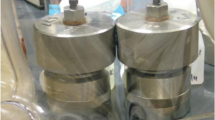Abstract
A mathematical model describing microbial transport and growth in a heterogeneous aquifer domain, composed of overlapping subdomains of high-permeability and low-permeability materials, is developed. Each material is conceptually visualized as a continuum which occupies the entire considered spatial aquifer domain. Based on the assumption that advection in the low-permeability domain is negligible, the mathematical model is solved by using a publically available reactive transport code. The importance of modeling microbial transport and growth in such a dual-porosity system is demonstrated through a hypothetical case study.
Similar content being viewed by others
References
Barenblatt, G. I., Zheltov, I. P. and Kochina, I. N.: 1960, Basic concepts in the theory of seepage of homogeneous fluids in fissure rocks, J. Appl. Math. Mech. Engng. Trans. 24(4), 1286-1303.
Bear, J.: 1979, Groundwater Hydraulics, McGraw-Hill, New York.
Bear, J., Nichols, E., Ziagos, J. and Kulshrestha, A.: 1994, Effect of contaminant diffusion into and out of low-permeability zones, Lawrence Livermore National Laboratory, Livermore, California.
Borden, R. C. and Bedient, P. B.: 1986, Transport of dissolved hydrocarbons influenced by oxygenlimited bioremediation: 1. Theoretical development, Water Resour. Res. 22(13), 1973-1982.
Carpenter, D.W.: 1984, Assessment of contamination in soils and groundwater at Lawrence Livermore National Laboratory, Sandia National Laboratories, Livermore, and Adjacent Properties, Lawrence Livermore National Laboratory, Livermore, California 94551 (UCAR-10180).
Clement, T. P., Hooker, B. S. and Skeen, R. S.: 1996, Numerical modeling of biologically reactive transport near nutrient injection well, J. Env. Engng. 122(9), 833-839.
Clement, T. P., Sun, Y., Hooker, B. S. and Petersen, J. N.: 1998, Modeling multi-species reactive transport in groundwater aquifers, Spring, Groundwater Monitoring and Remediation, 18(2), 79-92.
Cohen, R. M., Vincent, A. H., Mercer, J. W., Faust, C. R., Spalding, C. P. and Matthews, J.: 1994, Methods for monitoring pump-and-treat performance, Robert Kerr Environmental Research Laboratory, Ada, Oklahoma, EPA/600/R-94/123.
Corapcioglu, M.Y. and Haridas, A.: 1985, Microbial transport in soils and groundwater: a numerical model, Adv. Water Resour. 8, 189-199.
Corapcioglu, M. Y. and Haridas, A.: 1984, Transport and fate of microorganisms in porous media: a theoretical investigation, J. Hydrology 72, 149-169.
Dykhuizen, R. C.: 1990, A new coupling term for dual-porosity models, Water Resour. Res. 26(2), 351-356.
Gerke, H. H. and van Genuchten, M. T.: 1993a,Adual-porosity model for simulating the preferential movement of water and solutes in structured porous media, Water Resour. Res. 29(2), 305-391.
Gerke, H. H. and van Genuchten, M. T.: 1993b, Evaluation of a first-order water transfer term for variably saturated dual-porosity flow models, Water Resour. Res. 29(4), 1225-1238.
Grisak, G. E. and Pickens, J. F.: 1980, Solute transfer through fractured media: 1. The effect of matrix diffusion, Water Resour. Res. 16(4), 719-730.
Harvey, R. W., Smith, R. L. and George, L.: 1984, Effect of organic contamination upon microbial distribution and heterotrophic uptake in a Cape Cod, MA Aquifer, Appl. Environ. Biol. 48, 1197-1202.
Lawrence, J. R. and Hendry, M. J.: 1996, Transport of bacteria through geologic media, Can. J. Microbiol. 42, 410-422.
Li, B., Loehle, C. and Malon, D.: 1996, Microbial transport through heterogeneous porous media: random walk, fractal, and percolation approaches, Ecological Modeling 85, 285-302.
Kindred, J. S. and Celia, M. A.: 1989, Contaminant transport and bioremediation: 2. Conceptual model and test simulations, Water Resour. Res. 25(6), 1149-1159.
Molz, F. J., Widdowson, M. A. and Benefield, L. D.: 1986, Simulation of microbial growth dynamic coupled to nutrient and oxygen transport in porous media, Water Resour. Res. 22(8), 1207-1216.
Rifai, S. H. and Bedient, P. B.: 1990, Comparison of biodegradation kinetics with an instantaneous reactions model for groundwater, Water Resour. Res. 26(4), 637-645.
Rittmann, B. E.: 1993, The significance of biofilms in porous media, Water Resour. Res. 29, 2195-2202.
Sun, Y.: 1995, Optimization of pump-treat-inject technology for remediation of contaminated aquifers, PhD Dissertation, Technion, Israel.
Tang, D. H., Frind, E. O. and Sudicky, E. A.: 1981, Contaminant transport in fractured porous media: analytical solution for a single fracture, Water Resour. Res. 17, 555-564.
Zheng, C.: MT3D, 1990, Amodular three-dimensional transport model for simulation of advection, dispersion and chemical reaction of contaminants in groundwater systems, USEPA Report.
Author information
Authors and Affiliations
Rights and permissions
About this article
Cite this article
Sun, Y., petersen, J.N., Bear, J. et al. Modeling Microbial Transport and Biodegradation in a Dual-porosity System. Transport in Porous Media 35, 49–65 (1999). https://doi.org/10.1023/A:1006551627151
Issue Date:
DOI: https://doi.org/10.1023/A:1006551627151




